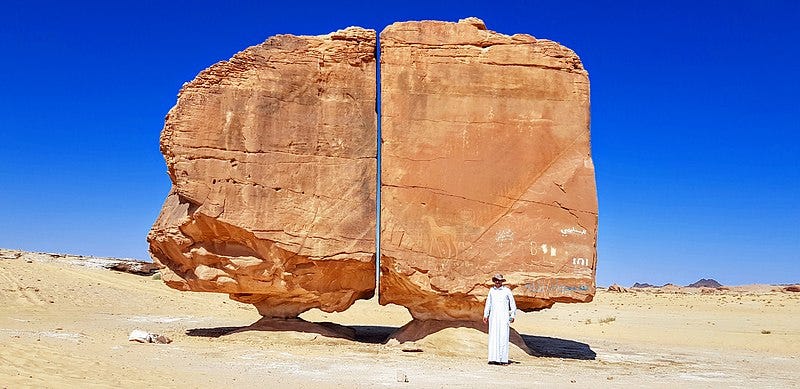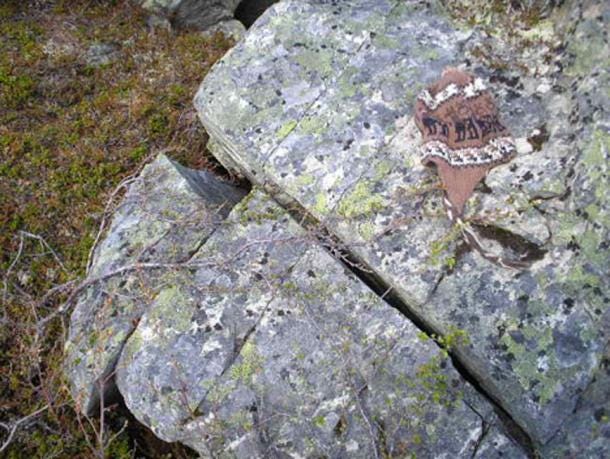The material commentary here is nonsense. This rock was cut across the natural grain while it sat secure upon what was likely a full base since eroded out. The cut itself was wide enough for us to look easily through from many yards away which looks rather wide.
Imagine a large long bronze blade rolling along of fine emory sand. This would make a cut that thick and possibly that clean. Just how did you think they cut the cladding stones for the great pyramid? they also had to be this good.
Rubbing fine emory sand can cut any rock you are likely ever to work with and a wide plate saw keeps it all good. My point here is that i could make this cut for the Great Pyramid in 2400 BC using bronze from Lake Superior and cornwall. The emory sand is found from placer deposits found occasionally. They have been reported to me in geolgical reports.
want to bet they did this to make a statement?.
Laser Precision: What Split the Ancient Al Naslaa Rock?
JUL 12
https://www.ancientoriginsunleashed.com/p/laser-precision-what-split-the-ancient?
Renowned for its spectacular rock art and rich historical heritage, the Tayma oasis in Saudi Arabia was once a bustling hub on the ancient trade routes. This oasis hosted Nabonidus, a Babylonian king, and appears in both Assyrian and Biblical records as a prominent trading stop. Dating back nearly 4000 years, the region boasts prolific rock art. Among these formations, the Al Naslaa rock stands out, a sandstone formation teetering atop a naturally eroded pedestal, split right down the middle by a perfectly straight fracture that gives the appearance of a laser cut.
Sculptures of the Arabian Sands
The Arabian Peninsula is largely composed of limestone, sandstone, and shale, which are laid over the west Arabian crystalline shield and a southern crystalline complex, remnants of prehistoric shallow sea environments. Over time, the merciless winds and rare rains of the Arabian desert have sculpted these rocks, creating captivating formations.
Al Madinah Province Saudi Arabia. (Saminathan Suresh/ CC BY SA 3.0 )
This split block carries significant archaeological weight due to the beautifully engraved rock art resembling a horse or camel. The lower section of the formation suggests it could be a ventifact—a geological formation resulting from the constant sandblasting of wind against rock. This process often results in unusually shaped rocks with smooth surfaces.
The White Desert of Egypt showcases ventifacts that resemble massive stone mushrooms sprouting from the earth. It's uncertain if the Al Naslaa formation is indeed a ventifact, although the bottom part that connects it to the ground suggests so. The smooth surface of the block's upper part lends credence to this theory, though its angular shape questions the claim.
Limestone rock formation in the White Desert, western Egypt. ( Public Domain )
Cracking the Rock: Weather or Lasers?
Geologists have theorized that the rock's remarkable fracture was caused by an offset in the ground beneath, forcing the rock to split. The region may be an old fault line, where the rock becomes fragile and erodes more easily, causing the straight cut when sand swept into the crevices over millennia.
Alternatively, the fracture may be due to the rock's jointing—the process where the rock is torn apart along weak zones due to pressure. Joints often appear almost artificially straight. In some climates, ice forms in these cracks, causing them to widen until the rock separates. The Al Naslaa rock has a few other fractures parallel to the major one, which might be joints, with the larger fracture possibly being a more advanced stage of the same process.
A rock in Abisko fractured along existing joints possibly by mechanical frost weathering. ( Chiton magnificus )
Yet, some observers propose a more extraordinary explanation. They suggest an ancient, advanced civilization, or even extraterrestrials, sliced the rock using lasers. While this can't be ruled out entirely, there's little evidence supporting the idea, save for the remarkably clean cut splitting the rock. The only obvious human intervention is the rock art, which seems unrelated to the split and covers only a portion of the rock, leaving the rest as natural sandstone.
Unless the laser theory involves a stray ray-gun blast, there's little reason to believe humans or other intelligent beings deliberately split the rock. The natural explanation, given the evidence of similar natural formations, remains the most probable. This brings to mind the naturally occurring perfect cubes formed by mineral pyrite, often mistaken for human craftsmanship.
Rock art on the Al Naslaa rock formation depicting a man leading a horse. Source: Arabian Rock Art Heritage.
Distinguishing Nature's Handiwork from Man's
People strive to make sense of patterns in their environment, often leaning on artificial constructs when natural explanations escape them. This can lead to both correct and incorrect conclusions, as demonstrated when archaeologists attempt to identify ancient stone tools—some may be genuine tools, while others are simply rocks.
Drawing from our understanding of natural phenomena and human influences, we aim to explain the mysteries around us. Yet, we must be cautious about jumping to conclusions too quickly. To assert that the Al Naslaa rock was shaped by an ancient laser implies a host of other extraordinary claims that would require equally extraordinary evidence. So, let's tread carefully, verifying our facts before entertaining fantastical theories.
Top Image: Al Naslaa split rock. Source: Disdero / CC by SA 4.0.
By Caleb Strom
Powers, R. W., et al. "Geology of the Arabian Peninsula—Sedimentary Geology of Saudi Arabia: USG
Survey Professional Paper, 560-D." (1966).
“Structural Geology and Tectonics” by Alessandro Grippo (2014.). Alessandro Grippo Ph.D. homepage. Available at: http://unusualplaces.org/al-naslaa-rock-formation/
“Al Naslaa Rock Formation.” Unusual Places. Available at: http://unusualplaces.org/al-naslaa-rock-formation/
“Ventifacts and Dreikanters.” Sand Atlas. Available at: http://www.sandatlas.org/ventifacts-and-dreikanters/
“Tayma.” Arabian Rock Heritage. Available at: http://saudi-archaeology.com/sites/tayma/





No comments:
Post a Comment